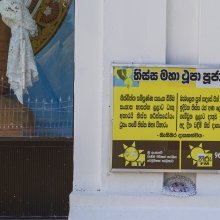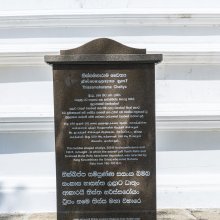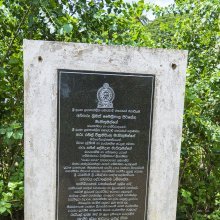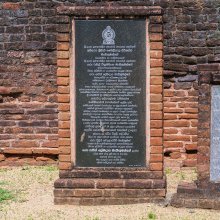Lalata, Lalāṭa: 25 definitions
Introduction:
Lalata means something in Buddhism, Pali, Hinduism, Sanskrit, Marathi, Hindi. If you want to know the exact meaning, history, etymology or English translation of this term then check out the descriptions on this page. Add your comment or reference to a book if you want to contribute to this summary article.
Images (photo gallery)
In Hinduism
Shaivism (Shaiva philosophy)
Source: academia.edu: The Śaiva Yogas and Their Relation to Other Systems of YogaLalāṭa (ललाट, “forehead”) refers to one of the sixteen types of “locus” or “support” (ādhāra) according to the Netratantra. These ādhāras are called so because they “support” or “localise” the self and are commonly identified as places where breath may be retained. They are taught in two different setups: according to the tantraprakriyā and according to the kulaprakriyā. Lalāṭa belongs to the latter system.
Source: Brill: Śaivism and the Tantric TraditionsLalāṭa (ललाट) refers to the “forehead” representing one of the nine Granthis (‘knots’ or ‘joints’), according to verse 4.497ff of the Brahmayāmala-tantra (or Picumata), an early 7th century Śaiva text consisting of twelve-thousand verses.—Accordingly, “[...] A series of nine lotuses is visualized situated at points in the body called granthis (knots or joints). These are located at the crown of the head, the forehead (lalāṭa), throat, navel, knees, mouth, heart, genitals, and feet, following the order of their sequence in nyāsa. The eight-petalled lotuses situated therein are loci for installation of the principal nine deities: Kapālīśabhairava, who is installed in the crown lotus, and two sets of four goddesses, the Devīs [i.e., Raktā, to be installed on the forehead] and the Dūtīs. [...]”.

Shaiva (शैव, śaiva) or Shaivism (śaivism) represents a tradition of Hinduism worshiping Shiva as the supreme being. Closely related to Shaktism, Shaiva literature includes a range of scriptures, including Tantras, while the root of this tradition may be traced back to the ancient Vedas.
Ayurveda (science of life)
Source: gurumukhi.ru: Ayurveda glossary of termsLalāṭa (ललाट):—[lalāṭaḥ] Forehead

Āyurveda (आयुर्वेद, ayurveda) is a branch of Indian science dealing with medicine, herbalism, taxology, anatomy, surgery, alchemy and related topics. Traditional practice of Āyurveda in ancient India dates back to at least the first millenium BC. Literature is commonly written in Sanskrit using various poetic metres.
Vastushastra (architecture)
Source: OpenEdition books: Architectural terms contained in Ajitāgama and RauravāgamaLalāṭa (ललाट) refers to “pinion §§ 3.12; 4.12.”.—(For paragraphs cf. Les enseignements architecturaux de l'Ajitāgama et du Rauravāgama by Bruno Dagens)

Vastushastra (वास्तुशास्त्र, vāstuśāstra) refers to the ancient Indian science (shastra) of architecture (vastu), dealing with topics such architecture, sculpture, town-building, fort building and various other constructions. Vastu also deals with the philosophy of the architectural relation with the cosmic universe.
Shaktism (Shakta philosophy)
Source: Google Books: Manthanabhairavatantram1) Lalāṭa (ललाट) refers to the “forehead” according to the Manthānabhairavatantra, a vast sprawling work that belongs to a corpus of Tantric texts concerned with the worship of the goddess Kubjikā.—Accordingly, “[...] (7) The Wheel of the Point (binducakra) is on the forehead [i.e., lalāṭa] and is the Unbroken Circle. Completely full of the sixteen energies (of the vowels), it is seen to be the lunar orb (candrabimba). [...] (Perfect) contemplation (samādhi) is with (these) sixteen aspects and is (attained) within the form of the sixfold deposition (ṣoḍhānyāsa). He who knows this is (a veritable) Lord of Yogis, the others (who do not) are (just) quoting from books. Once attained the plane that is Void and Non-void, the yogi is freed from bondage”.
2) Lalāṭa (ललाट) refers to the “forehead”, corresponding the Pūrvāmnāya system: one of the sixteen spiritual disciplines (darśana) issued from the limbs of the body of the Goddess, according to the Manthānabhairavatantra.—[...] All spiritual disciplines, whatever the tradition, are necessarily grounded in the same energy of the Śāmbhava state. They issue, as the texts put it, from the limbs of the body of the goddess who is this energy. These range from the lowest extremity—the left big toe—where Buddhism originates, to the highest—the End of Sixteen—where the Śāmbhava state is attained which is the source of the Kubjikā tradition. The systems (darśana) and their corresponding places of origin in the Goddess’s body are as follows: [9) Pūrvāmnāya—the forehead—lalāṭa, ...].

Shakta (शाक्त, śākta) or Shaktism (śāktism) represents a tradition of Hinduism where the Goddess (Devi) is revered and worshipped. Shakta literature includes a range of scriptures, including various Agamas and Tantras, although its roots may be traced back to the Vedas.
Yoga (school of philosophy)
Source: Google Books: Croaking Frogs: (Yoga)Lalāṭa (ललाट) refers to the “forehead” representing one of the sixteen vital centres of the body (i.e., ādhāra), according to the Jyotsnā 3.73 (Cf. Gorakṣaśataka 14 and Svātmārāma’s Haṭhapradīpikā 3.72).—In Haṭhayoga, ādhāra refers to a vital point of the body, a seat of vital function. Jyotsnā verse 3.73 cites a passage attributed to Gorakṣa listing the ādhāras as [e.g., lalāṭa (forehead), ...]. The Haṭhapradīpikā refers to sixteen ādhāras but does not name them or explain what they are. The Gorakṣaśataka also refers to sixteen ādhāras as something the Yogī should be familiar with, but does not name them.

Yoga is originally considered a branch of Hindu philosophy (astika), but both ancient and modern Yoga combine the physical, mental and spiritual. Yoga teaches various physical techniques also known as āsanas (postures), used for various purposes (eg., meditation, contemplation, relaxation).
Jyotisha (astronomy and astrology)
Source: Wisdom Library: Brihat Samhita by VarahamihiraLalāṭa (ललाट) refers to the “forehead”, according to the Bṛhatsaṃhitā (chapter 2), an encyclopedic Sanskrit work written by Varāhamihira mainly focusing on the science of ancient Indian astronomy astronomy (Jyotiṣa).—Accordingly, “We shall now proceed to give a brief description of (the qualifications of) a jyotiṣaka. He must be of noble birth and of agreeable appearance; meek, truthful and without jealousy; of proportional limbs; of joints well built and of good growth; have no physical defects; be of fine hands, feet, nails, eyes, chin, teeth, ears, forehead [i.e., lalāṭa], eye-brows and head; of fine physique and of high, sonorous voice”.

Jyotisha (ज्योतिष, jyotiṣa or jyotish) refers to ‘astronomy’ or “Vedic astrology” and represents the fifth of the six Vedangas (additional sciences to be studied along with the Vedas). Jyotisha concerns itself with the study and prediction of the movements of celestial bodies, in order to calculate the auspicious time for rituals and ceremonies.
Purana and Itihasa (epic history)
Source: archive.org: Shiva Purana - English TranslationLalāṭa (ललाट) refers to the “forehead”, according to the Śivapurāṇa 2.3.10.—Accordingly, as Brahmā narrated to Nārada:—“[...] Thus Śiva remained for a long time eliminating the three attributes, and unaffected by aberrations. The lord Himself, the controller of illusion remained in the state of the Supreme Brahman. Then He gave up trance. Many years elapsed. What happened thereafter, I shall now recount to you. The drops of sweat caused by exhaustion fell on the Earth from the lord’s forehead [i.e., lalāṭa-deśa] and took the shape of a child immediately. [...]”.

The Purana (पुराण, purāṇas) refers to Sanskrit literature preserving ancient India’s vast cultural history, including historical legends, religious ceremonies, various arts and sciences. The eighteen mahapuranas total over 400,000 shlokas (metrical couplets) and date to at least several centuries BCE.
Kavya (poetry)
Source: Brill: Śaivism and the Tantric Traditions (kavya)Lalāṭa (ललाट) refers to the “forehead”, according to Bāṇa’s Kādambarī (p. 225-226).—Accordingly, while describing the shire of the Goddess Caṇḍikā, “[Then follows the image of the Goddess Caṇḍikā, which matches the conception of Kālarātri in the passage from the Mahābhārata:] [...] she bore the coquettish apparel of a woman going out to meet Mahākāla at night, with a vine-like body furnished with a raiment reddened with saffron-dye, with a face with red eyes, whose brows were furrowed into a frown, whose lip was crimsoned with betel that was blood, whose cheeks were reddened by the light shed from ear-ornaments of pomegranate flowers, with a forehead (lalāṭa) on which there was a tilaka dot of vermillion made by a Śabara beauty, covered by a magnificent gold turban. She was worshipped by goats... mice... antelope and black serpents... She was praised on all sides by flocks of old crows; [...]”.

Kavya (काव्य, kavya) refers to Sanskrit poetry, a popular ancient Indian tradition of literature. There have been many Sanskrit poets over the ages, hailing from ancient India and beyond. This topic includes mahakavya, or ‘epic poetry’ and natya, or ‘dramatic poetry’.
Shilpashastra (iconography)
Source: Shodhganga: Elements of Art and Architecture in the Trtiyakhanda of the Visnudharmottarapurana (shilpa)Lalāṭa (ललाट) or “forehead” refers to one of the various body parts whose Measurements should follow the principles of ancient Indian Painting (citra), according to the Viṣṇudharmottarapurāṇa, an ancient Sanskrit text which (being encyclopedic in nature) deals with a variety of cultural topics such as arts, architecture, music, grammar and astronomy.—In the Viṣṇudharmottarapurāṇa, a specific measurement of every limb of a man as well as of a woman is elaborately and systematically discussed. In this book, the writer has presented the measurement of almost all the body parts that should be maintained in a picture. For example, Lalāṭa (“forehead”) should be 4 X 8 aṅgulas.

Shilpashastra (शिल्पशास्त्र, śilpaśāstra) represents the ancient Indian science (shastra) of creative arts (shilpa) such as sculpture, iconography and painting. Closely related to Vastushastra (architecture), they often share the same literature.
In Buddhism
Tibetan Buddhism (Vajrayana or tantric Buddhism)
Source: OSU Press: Cakrasamvara SamadhiLalāṭa (ललाट) refers to the “forehead” and is associated with the syllable jāṃ, according to the Cakrasaṃvara Samādhi [i.e., Cakrasamvara Meditation] ritual often performed in combination with the Cakrasaṃvara Samādhi, which refers to the primary pūjā and sādhanā practice of Newah Mahāyāna-Vajrayāna Buddhists in Nepal.—Accordingly, “[Do caturviṃśati-aṅga nyāsa; Touch twenty-one parts of one’s body with right middle finger, and recite seed syllables] ... Jaṃ on the forehead (jāṃ lalāṭe)”.

Tibetan Buddhism includes schools such as Nyingma, Kadampa, Kagyu and Gelug. Their primary canon of literature is divided in two broad categories: The Kangyur, which consists of Buddha’s words, and the Tengyur, which includes commentaries from various sources. Esotericism and tantra techniques (vajrayāna) are collected indepently.
Languages of India and abroad
Pali-English dictionary
Source: Sutta: The Pali Text Society's Pali-English DictionaryLalāṭa, see nalāṭa (cp. laṅgula). (Page 582)

Pali is the language of the Tipiṭaka, which is the sacred canon of Theravāda Buddhism and contains much of the Buddha’s speech. Closeley related to Sanskrit, both languages are used interchangeably between religions.
Marathi-English dictionary
Source: DDSA: The Molesworth Marathi and English Dictionarylalata (ललत).—m A Rag or mode of music. Sung in uttararātra or after midnight. See rāga.
--- OR ---
lalāṭa (ललाट).—n (S) The forehead. 2 Popularly understood as the spot betwixt the eyebrows.
Source: DDSA: The Aryabhusan school dictionary, Marathi-Englishlalāṭa (ललाट).—n The forehead.
Marathi is an Indo-European language having over 70 million native speakers people in (predominantly) Maharashtra India. Marathi, like many other Indo-Aryan languages, evolved from early forms of Prakrit, which itself is a subset of Sanskrit, one of the most ancient languages of the world.
Sanskrit dictionary
Source: DDSA: The practical Sanskrit-English dictionaryLalāṭa (ललाट).—[laḍ-ac ḍasya laḥ, lalamaṭati aṭ-aṇ vā Tv.] The forehead; लिखितमपि ललाटे प्रोज्झितुं कः समर्थः (likhitamapi lalāṭe projjhituṃ kaḥ samarthaḥ) H.1.19; N. 1.15.
Derivable forms: lalāṭam (ललाटम्).
Source: Cologne Digital Sanskrit Dictionaries: Shabda-Sagara Sanskrit-English DictionaryLalāṭa (ललाट).—n.
(-ṭaṃ) The forehead. E. lala wish or dalliance, from laḍ with ac aff., aṭ to go or be, aff. aṇ; also with kan added lalāṭaka n. (-kaṃ) .
Source: Cologne Digital Sanskrit Dictionaries: Benfey Sanskrit-English DictionaryLalāṭa (ललाट).—n. The forehead, [Pañcatantra] ii. [distich] 183; [Vikramorvaśī, (ed. Bollensen.)] 73, 8.
Source: Cologne Digital Sanskrit Dictionaries: Cappeller Sanskrit-English DictionaryLalāṭa (ललाट).—[neuter] forehead, [locative] in front.
--- OR ---
Lālāṭa (लालाट).—[adjective] being on the forehead (also ṭika); [feminine] ṭī forehead.
Source: Cologne Digital Sanskrit Dictionaries: Monier-Williams Sanskrit-English Dictionary1) Lalāṭa (ललाट):—n. (later form of rarāṭa q.v.) the forehead, brow, [Atharva-veda] etc. etc. (ṭe ind. on the forehead, in front; the destiny of every individual is believed by the Hindūs to be written by Brahmā on his forehead on the 6th day after birth See, [Religious Thought and Life in India 370])
2) Lālāṭa (लालाट):—mf(ī)n. ([from] lalāṭa) being in or on the forehead, relating to it etc., [Prabodha-candrodaya]
Source: Cologne Digital Sanskrit Dictionaries: Yates Sanskrit-English DictionaryLalāṭa (ललाट):—(ṭaṃ) 1. n. The forehead.
Source: DDSA: Paia-sadda-mahannavo; a comprehensive Prakrit Hindi dictionary (S)Lalāṭa (ललाट) in the Sanskrit language is related to the Prakrit words: Ṇaḍāla, Ṇiḍala, Ṇiḍāla, Ṇilāḍa.
[Sanskrit to German]
Sanskrit, also spelled संस्कृतम् (saṃskṛtam), is an ancient language of India commonly seen as the grandmother of the Indo-European language family (even English!). Closely allied with Prakrit and Pali, Sanskrit is more exhaustive in both grammar and terms and has the most extensive collection of literature in the world, greatly surpassing its sister-languages Greek and Latin.
Hindi dictionary
Source: DDSA: A practical Hindi-English dictionaryLalāṭa (ललाट) [Also spelled lalat]:—(nm) forehead; destiny, fortune; -[rekhā, -kā likhā] writ of (individual) destiny; •[amiṭa hai] what is lotted cannot be blotted; —[meṃ honā] to be the writ of destiny, to be one’s fate.
...
Kannada-English dictionary
Source: Alar: Kannada-English corpusLalāṭa (ಲಲಾಟ):—
1) [noun] the part of the face between the eyebrows and the line where the hair normally begins; the forehead.
2) [noun] a kind of embrace by a man and a woman pressing the foreheads mutually.
--- OR ---
Lālāṭa (ಲಾಲಾಟ):—[adjective] being on or in the forehead.
--- OR ---
Lālāṭa (ಲಾಲಾಟ):—[noun] the forehead (of a human being).
Kannada is a Dravidian language (as opposed to the Indo-European language family) mainly spoken in the southwestern region of India.
See also (Relevant definitions)
Starts with (+6): Lalatabimba, Lalatadesha, Lalatadhatuvamsa, Lalataja, Lalataka, Lalataksha, Lalatalekha, Lalatalikhita, Lalatalombata, Lalatam, Lalatamtapa, Lalatanetra, Lalatantapa, Lalatantuyutammutra, Lalatapatta, Lalatapattaka, Lalatapattika, Lalataphalaka, Lalatapura, Lalatarekha.
Ends with (+3): Avimlanalalata, Balalata, Candralalata, Jalalata, Kapilalata, Karnatalalata, Kholalata, Kuchilalata, Mahalalata, Muktaphalalata, Nimnalalata, Pralalata, Prithulalata, Rukmalalata, Samalalata, Shitilalata, Simhalalata, Sulalata, Suparinatalalata, Tolalata.
Full-text (+55): Lalatapatta, Lalatatata, Lalatika, Lalatarekha, Rarata, Lalatalekha, Lalati, Lalataka, Nalata, Lalataphalaka, Lalatam, Yalilalatam, Lalatamtapa, Lalatapattika, Mahalalata, Tripataka, Lalataksha, Lalat, Lalatadesha, Lalatapattaka.
Relevant text
Search found 26 books and stories containing Lalata, Lalāṭa, Lālāṭa; (plurals include: Lalatas, Lalāṭas, Lālāṭas). You can also click to the full overview containing English textual excerpts. Below are direct links for the most relevant articles:
Garga Samhita (English) (by Danavir Goswami)
Verse 3.8.7 < [Chapter 8 - The Opulences of Śrī Girirāja]
Vishnudharmottara Purana (Art and Architecture) (by Bhagyashree Sarma)
7(a): Portrait of Men and Women < [Chapter 5 - Painting and Image Making]
Bhakti-rasamrta-sindhu (by Śrīla Rūpa Gosvāmī)
Verse 1.2.122 < [Part 2 - Devotional Service in Practice (sādhana-bhakti)]
Amarakoshodghatana of Kshirasvamin (study) (by A. Yamuna Devi)
External Anatomy < [Chapter 3 - Social Aspects]
Cidgaganacandrika (study) (by S. Mahalakshmi)
Verse 183 [Cidānandamayī Śakti enfolds the projection in one’s Self] < [Chapter 4 - Fourth Vimarśa]
Atharvaveda and Charaka Samhita (by Laxmi Maji)
Treatment of Śīrṣakti (headache) < [Chapter 3 - Diseases and Remedial measures (described in Atharvaveda)]



